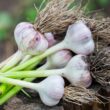In This Article Show
As an avid gardener with over a decade of hands-on experience, I’ve come to appreciate the subtle complexities and rewarding moments that come with cultivating these versatile bulbs. Onions are not just a kitchen staple; they’re a cornerstone of culinary traditions worldwide, which makes understanding their lifecycle even more crucial for enthusiasts and gardeners alike.
The path to a bountiful onion harvest begins with a solid grasp of the plant’s growth stages, from the initial germination of seeds to the final maturation and harvesting. This knowledge not only enhances our gardening practices but also deepens our connection to the food we grow and consume.
In this guide, we’ll explore the critical phases in the life of an onion plant, shedding light on the optimal conditions and care needed at each step. By the end, you’ll have a comprehensive understanding of how to nurture these plants, ensuring they thrive from seed to harvest.
Onions Growth Stages & Timelines
1. Seed Germination Stage

The journey of growing onions begins beneath the soil’s surface, where the magic of germination takes place. Understanding this initial stage is crucial for setting the foundation of a successful onion crop. Let’s break down the timeframe and conditions necessary for onion seed germination, combining knowledge from my years of gardening with practical advice.
Timeframe for Onion Seed Germination
Onion seeds typically embark on their germination journey within 7 to 10 days after planting, assuming conditions are within the optimal range. This timeframe can slightly vary depending on the variety of onions and the specific environmental conditions. Patience is key during this period, as the natural processes unfold beneath the earth.
Get Gardening For Beginners
Our new EBOOK shows newcomers and green thumbs alike a step by step guide to growing the garden of their dreams.
Conditions Necessary for Successful Germination
For onion seeds to germinate effectively, several conditions must be met:
- Temperature: Onion seeds thrive in a temperature range between 68°F to 77°F (20°C to 25°C). This warm environment stimulates the seeds, encouraging them to break dormancy and sprout.
- Moisture: Keeping the soil consistently moist but not waterlogged is essential for germination. The soil should feel like a well-wrung sponge – damp to the touch but not dripping wet.
- Soil Quality: Use loose, well-draining soil rich in organic matter. The soil should allow easy root penetration and provide the necessary nutrients for the young seedlings to grow strong.
- Light: Although onion seeds don’t require light to germinate, ensuring that young seedlings receive ample sunlight or artificial light post-germination is crucial for healthy development. Aim for at least 6-8 hours of direct sunlight per day once seedlings emerge.
2. Seedling Stage

After the initial excitement of germination, the onion enters the seedling stage, where the foundation for a healthy plant is built. This stage is marked by the emergence of the first true leaves, distinguishing them from the initial sprout. The seedlings will start to show their characteristic green shoots, which will become more robust over time.
Caring for Onion Seedlings
- Watering: Onion seedlings require consistent moisture to support their rapid growth. Water gently to avoid dislodging the young plants, aiming to keep the soil moist but not saturated.
- Spacing: Transplanting or thinning seedlings should be done when they are 2–3 inches tall, maintaining a spacing of about 1 inch apart for ample growth space.
- Soil Conditions: Continue to ensure the soil is rich in organic matter and well-draining. A balanced, slow-release fertilizer can be introduced at this stage to support growth. The pH of the soil should ideally be between 6.0 and 7.0 for onions.
3. Bulbing Stage

As daylight hours lengthen or shorten, depending on the onion variety, the plants are triggered to start forming bulbs, entering the bulbing stage. This is a critical phase in the onion’s lifecycle, where the plant begins to store energy in the form of a bulb beneath the soil surface.
Triggering the Bulbing Stage
Onions are day-length sensitive plants. Long-day onions start bulbing when the daylight reaches 14–16 hours, while short-day onions begin this process with 10–12 hours of daylight. Intermediate-day onions fall somewhere in between. Understanding your variety’s requirements is key to successful bulbing.
Get Gardening For Beginners
Our new EBOOK shows newcomers and green thumbs alike a step by step guide to growing the garden of their dreams.
Supporting Optimal Bulb Development
- Nutrition: At this stage, a phosphorus-rich fertilizer can encourage robust bulb development. Avoid nitrogen-heavy feeds, which can promote more leaf growth at the expense of the bulb.
- Watering: Reduce watering as the bulbs mature to prevent rot and disease. Allow the soil to dry out slightly between watering.
4. Maturation Stage

The maturation stage is evident when the onion tops begin to fall over and yellow, signaling that the bulbs are almost ready for harvest. This natural progression indicates that the onion is shifting its energy from growing to storing within the bulb.
Environmental Factors Affecting Maturation
- Temperature: Cooler temperatures can slow down the maturation process, while excessively high temperatures can speed it up, sometimes at the cost of quality.
- Water: As mentioned, reducing water as the bulbs mature is crucial. Too much moisture late in the game can lead to bulb rot or disease.
5. Harvesting Stage

Determining the right time to harvest onions is crucial for ensuring they store well and maintain their flavor.
Determining the Right Time to Harvest
When about half of the onion tops have fallen over and begun to yellow, it’s a good indicator that harvest time is near. Generally, this occurs late in the summer, but timing can vary based on planting time and local climate conditions.
Steps for Harvesting Onions Properly
- Wait for Dry Weather: Attempt to choose a dry period for harvesting. Pull or gently dig around the onions to loosen them from the soil.
- Harvest Gently: Lift the onions out of the soil carefully to avoid bruising. Bruised onions will not store well.
- Curing: Lay the harvested onions in a dry, ventilated area, preferably with sunlight, for a week or two to cure. This process allows the outer layers to dry and protects the onion during storage.
Understanding these stages and providing the care onions need at each phase will help ensure a bountiful and high-quality harvest. Each stage brings its own set of challenges and rewards, reflecting the fascinating lifecycle of this essential culinary crop.










